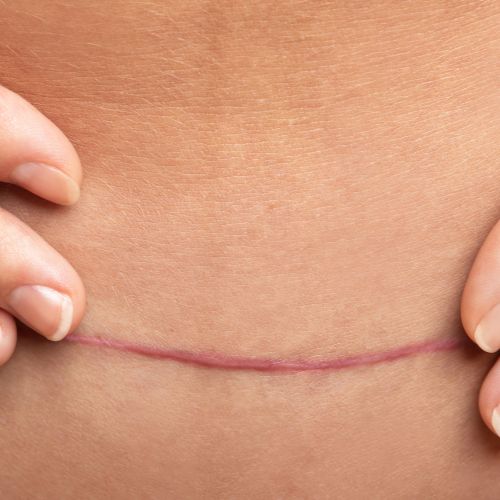
As you know, scars come in all sizes and colors! From the small and discreet whitish one, to the very big one following a surgical operation, to the pink and swollen one, scars do as they please… For some, aesthetic scars are far from reality. Others on the other hand, will have made only a brief appearance.
But then again, how is a scar formed? What are the different type of scars? What does a scar look like? What are scars healing processes? Do scars go away? If not, how can you treat scars? Want to find out about this and more? Keep on reading then!
One thing I can already tell you though is that scars are here to stay…
What is a scar?
To put it simply, scars are a permanent patch of skin that grows over a wound. Yet, how is a scar formed? Well, scars appear when the body heals after a cut, scrape, burn or sore. They can also result after surgery where the skin is cut, infections such as chickenpox, or skin conditions such as acne.
Scars are usually thicker, as well as pinker, redder or brighter than the rest of the skin. Yet, through time they might rather have a whitish or blackish appearance.
Scar healing process
You might still be wondering though how are scars formed precisely right? Well, once the skin as a wound, your body enters a physiological healing process composed of various stages. Yet do scars go away? Not really, it may fade away through time though.
However, to know how is a scared formed, you should before know the wound healing process. Indeed, scar healing stages are divided in 4 phases: hemostasis, inflammation, proliferation, and maturation.

Hemostasis
It occurs right after you’ve wounded yourself. In this phase, the body activates its emergency repair system. Hemostasis is the physiological process of the human body responsible for keeping the blood flowing inside the blood vessel. It is what is usually called blood clotting. Hemostasis is the opposite of Hemorrhage.
Inflammatory phase
It lasts about three to five days. It is also known as the defensive phase. It focuses on destroying bacteria and removing waste. Preparing the wound bed for the growth of new tissue.
Proliferation
Here, the goal is to regenerate tissue and cover your wound. It usually lasts between 4 to 24 days. The proliferation phase has three distinct stages: Regenerating the wound tissue; Contracting the wound margins; Covering the wound otherwise known as the epithelialization.
Maturation
This phase is also known as the remodeling phase. Plus, its duration may vary between 21 days to 2 years, depending on the type of wound. During the maturation phase, the new tissue slowly gains strength and flexibility. Here, collagen fibers reorganize, tissue regenerates and matures. There is an overall increase in the traction strength.
Does the age affects the scar healing process?

The healing speed is inversely proportional to the age of the patient. This will affect how is a scar formed and what does a scar look like. This means that as you age, your scarring may take longer than a few years ago!
Yet, it is important to highlight the fact that scars healing process in patients younger than 30 years old will most likely have a worse final aesthetic scar than in those older than 55. Yes, you read correctly, being old helps you heal with less scarring!
Indeed, “Dermatologists and plastic surgeons have consistently observed that older people’s wounds heal with thinner scars than younger patients”. Yet this event was until recently a mystery though. If you want to find out more about the scar healing process and age, click here.
Keep in mind though that the scar tissue will never regain the same tensile strength as the surrounding normal skin. Usually, you can expect about 80% of your initial strength once healed.
What are the different type of scars?
Scars appear when skin tissue suffers injuries. The organism regenerates, causing the closure of the dermis, thereby resulting in a scar. Most lesions are caused by accidents, pathologies. The might even caused by surgeries, such as Abdominoplasties, cesarean sections, silicon prostheses, etc. Some may even be classified as aesthetic scars! Hence, as you may have seen, there are different type of scars. Yet, the five most common types of scars are:
Normotrophic scars

A normotrophic scar occurs when the scarred tissue is very similar to intact skin. Thus, the scarring occurs in the best possible manner. There is practically no high relief, consistency, or different skin texture seen when talk about Normotrophic scar. The extension of the scar lesion is aligned to the intact skin.
Hypertrophic Scar

The hypertrophic scar customarily has a raised profile when compared to the surrounding intact skin tissue. This means that it is formed by a saliency, high relief of the tissue at the same cross-section. The hypertrophic scar is often confused as a keloid.
Keloid Scar

The keloid scar, as previously mentioned, can be confused with the hypertrophic scar. The most significant difference between them is that the keloid exceeds the lesion. Meaning that there is high relief extending beyond the injured skin.
Atrophic Scar

The atrophic scar is distinct from the hypertrophic scar as it is characterized by a sunken appearance of the skin. That occurs due to compromised tissue, contributing to the absence of firmness and support for the skin. Quite often, concavities may form arising from acne lesions.
Contraction

Contractions are scars preventing bodily movement due to the junction of tissues. It is usually from an abnormal occurrence that appears when a large area of skin is lost or highly damaged. While forming, it pulls the edges of the skin together transforming the damaged area into a tight type of skin. This type of scar is common sequelae from burns.
Scar treatment: what is the best scar treatment?
There are many different types of treatments to heal scars. Especially, when you consider the fact that there are many different type of scars!
Yet, do scars go away? It is important to emphasize once again that in no case can a scar be eliminated, but in most cases, they can become a more aesthetic scar. Sometimes even become almost imperceptible.
The degree of improvement of the scar will be conditioned by several factors, including the size and location of the scar. Since, as you now know, there are many different type of scars and many factors are involved in how is a scar formed.
The treatments that can be used to reduce or disguise scars can be classified as non-invasive, invasive and others.
Non-invasive scar treatments
To put it briefly this group includes compressive bandages, silicone gels, topical creams, or ointments. As well as, on another level, psychological treatment.
For instance, the compressive bandage is a type of treatment that has been used for years, with effective results, in burn centers. They flatten and soften the scar in a high percentage of cases (approximately 65-75%).
Yet, usually, the most common non-invasive scar treatment would be creams and ointments. There are many creams, ointments or ointments on the market that can be used for the treatment of scars. Some of their main components are vitamins A and E, centella asiatica, zinc, rosehip, etc. In some cases, cortisone creams are used. although it is not a usual treatment in the treatment of keloids and hypertrophic scars.

Invasive scar treatments
This section includes surgery, injected corticosteroids, cryotherapy, radiotherapy, laser and scar camouflage tattoo.
Bear in mind that surgery It is a second-choice treatment in the treatment of scars. As a general rule, surgery is a type of treatment for adults and will be used exclusively for very complex scars. Or scars that do not respond to other less invasive treatments.
Another well-known scar treatment is the laser. Yet, laser may seem like a magic wand that can make any scar disappear. However, medical lasers are no joking matters. To achieve impressive results and avoid serious side effects, it is important to keep in mind that the laser won’t make your scar go away. You’ll need various sessions and results depend greatly on the professional capability.
On the other hand, you can try out the scar camouflage tattoo. This medical tattooing for scars consist in develop a totally customized pigment mixture for you. Applying it to the marks you wish to hide. Various sessions when you want a scar camouflage tattoo. But, results achieved with the Brazilian camouflage technique are jaw-dropping!


Takeaway
There are many different type of scars. Yet the healing process of most are remarkable and complex. You must be careful to clean it approppiately while healing since scarring can be disturbed due to local and systemic factors. Including moisture, infection, age, nutritional status and body type.
Regardless of how is a scar formed and the scar healing process, when the correct healing environment is established, the body works wonders. Healing and replacing devitalized tissue and may even create aesthetic scars.
So, do scars go away? You now know that they don’t! Yet, you can diminish its appearance making it sometimes even barely visible. Nowadays, you can even try out the scar camouflage tattoo. Which has done wonders in rebuilding people self-esteem back. But, more importantly, it has helped thousand of individuals enjoy their life like they’ve only dared to dream so far.
Keep in mind though that, like all medical procedures you must carefully choose your scar camouflage professional!